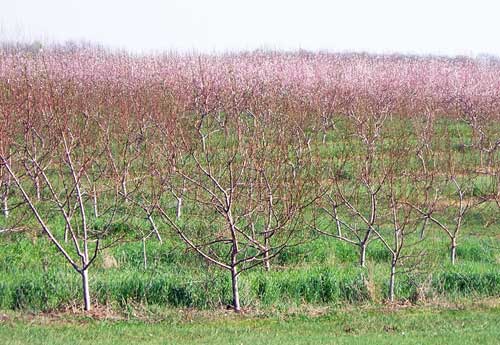Winter cold hardiness in Michigan fruit crops
Michigan fruit plants are well adapted to withstand a Michigan winter.
The perennial fruits grown in Michigan can withstand most of the conditions of a Michigan winter. They withstand several months of temperatures below freezing and generally show little injury to the winter cold. They do this by becoming dormant and cold hardy.
In the fall, plants enter a dormant period called endo-dormancy (see the Michigan State University Extension article, “Fall color show and winter dormancy in woody plants”). During endo-dormancy, plants slowly accumulate chilling units to track the passage of time in the winter (see the MSU Extension article “Winter dormancy and chilling in woody plants”). When the plants are in endo-dormancy they acclimate to the cold conditions around them. The plant’s basic cellular components and metabolism change to withstand cold and freezing. As colder temperatures become more common, the plants acclimate to the increased cold. Extreme winter cold will cause little or no damage if the plants, including trees, vines or bushes, are acclimated. Most acclimated fruit plants can easily withstand cold temperatures 10 to 20 degrees Fahrenheit colder than the temperatures they are experiencing. The maximum cold hardiness of Michigan fruit crops ranges from about 0 or -5 F for cold tender wine grapes to -35 F for cold hardy apples.
One of the reasons Michigan is such an outstanding fruit production region is Lake Michigan. One of the effects of Lake Michigan in the winter is to moderate the temperature of the cold air passing over it. Temperatures close to the lake are seldom below zero while temperatures down to -10 or -20 F are common inland away from the lake. This is why cold tender fruits like wine grapes, peaches, blueberries and cherries are grown in the so called Michigan Fruit Belt along Lake Michigan’s eastern shore. Under the moderating influence of Lake Michigan, winter cold seldom damages the crop, assuring regular harvests.
Sudden drops in temperature of 20 degrees or more may cause damage or winter injury (i.e., when the low temperature one night is 20 degrees colder than the night before). This is especially true if the cold snap is preceded by warm weather. When warm weather with temperatures above freezing occurs in the winter, the plants lose the extra cold hardiness they have accumulated. If warm temperatures occur before a cold snap, injury is more likely. Plants lose their enhanced cold hardiness and revert to what I call the base cold hardiness. This is the minimum hardiness that a plant has during endo-dormancy. The minimum cold hardiness of most Michigan plants is around 10 to 0 F, depending on the plant. My rule of thumb is that if we have one day when the temperature stays above freezing, we have lost a lot of our cold hardiness, and if we have 48 hours or more of warm weather above freezing ,then most plants are at their minimum cold hardiness.
Renewed cold will cause the plant to reacquire its lost cold hardiness. Plants acclimate to the cold much more slowly than they lose their cold hardiness. While they can lose all their cold hardiness in a day or two, they only acquire 1 to 4 degrees of enhanced cold hardiness for every day below freezing. There is a maximum cold hardiness that a plant can attain and temperatures below this are damaging or fatal to the plant. There are also different levels of cold hardiness for different plant parts. Often flower buds are more susceptible to winter cold injury. For example, peach flower buds begin to freeze and die at -13 to -15 F and most are gone by the time the temperatures are below -16 F, but the tree itself is not damaged until the temperature drops below -20 or -25 F. This relatively wide range of injury varies for each plant species.

The peaches in the foreground of this picture were damaged by winter
cold that collected in the cold pocket in the low areas of the orchard.
The temperatures were cold enough to kill the flower buds, but left the
tree relatively undamaged. Photo credit: Mark Longstroth, MSUE
During the winter, a plant in Michigan will gain and lose cold hardiness several times. The temperatures before a freeze are very important in determining if a given plant will be damaged. The worst conditions are when we have several days above freezing followed by a cold snap with temperatures dropping into the single digits or below zero. It is even worse if a second cold snap drops low temperatures well below zero. Temperatures into the negative teens make many growers nervous. Temperatures to -20 F or lower worry all fruit growers.
In almost 20 years of working with the Michigan fruit industries, I have seen widespread damage due to extreme winter cold only once in the winter of 1993-94 when temperatures fell -20 F and below. Injury is more likely to occur in the late winter after the chilling requirement has been met and growth begins. Once growth begins, the cold tolerance to the buds and shoots is dependent on their stage of development.
Related MSU Extension articles



 Print
Print Email
Email


